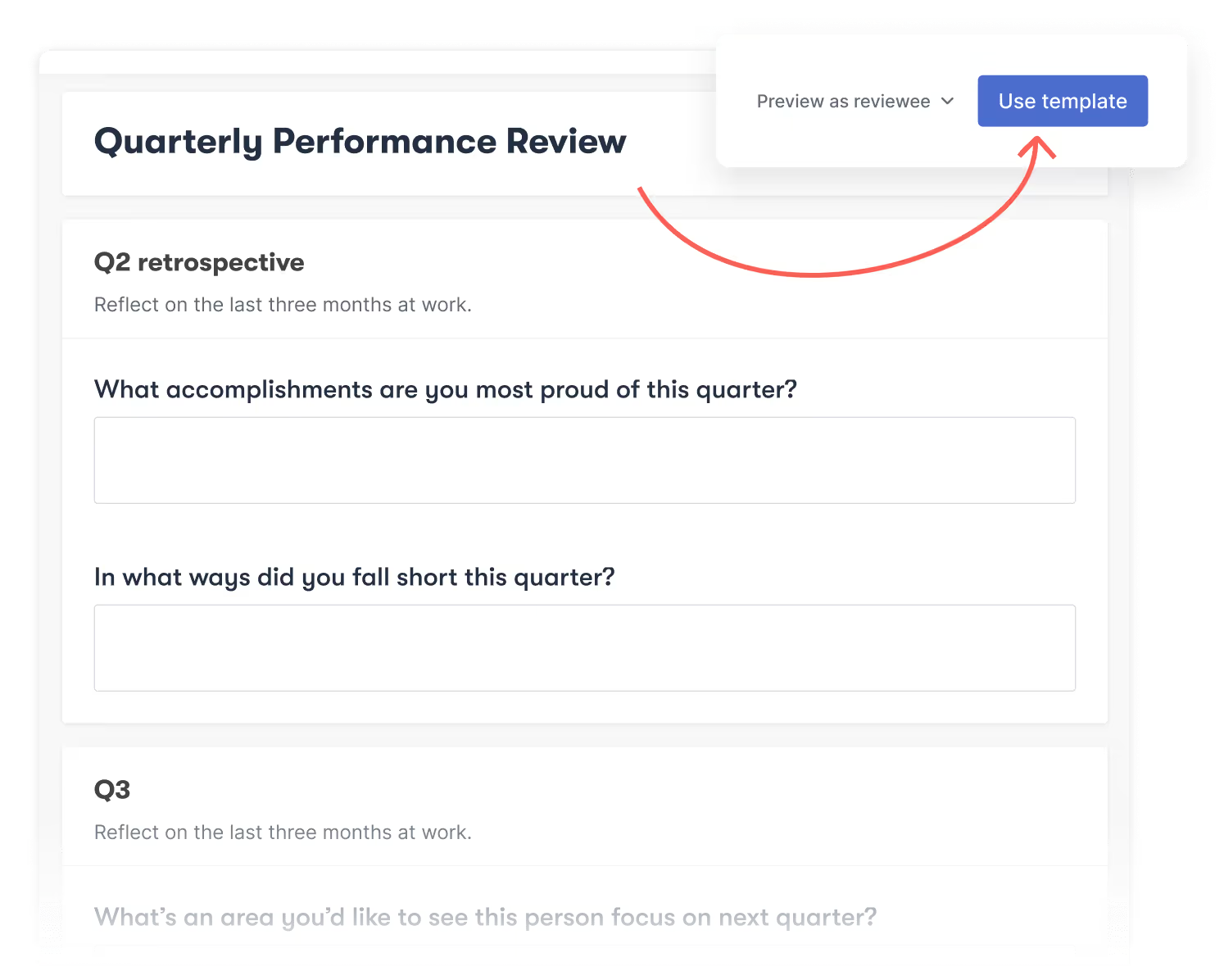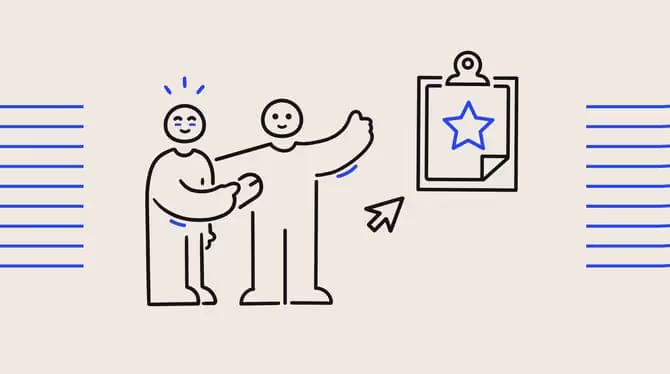Mastering employee performance reviews: A guide for managers

Discover Workleap Officevibe's benchmark report on 12 key employee engagement metrics

When you hear "performance review," what comes to mind? As a manager, do you think of it as a once-a-year task that's just part of your checklist? Or perhaps, do you think of it as a laborious process with no clearly useful output?
Rest assured; the performance review process can be utilized strategically and absolutely be done in a way that is structured, effective, and impactful.
In this article, you'll find your ultimate guide to employee performance reviews. We'll walk you through the essential steps involved in conducting effective performance reviews and provide guidance on what a successful review should look like — before, during, and after. When done right, they can contribute to employee growth, development, and higher business performance.
What is an employee performance review?
Let's first cover the basics. At its core, a performance review is a structured process that evaluates an individual's job performance and provides constructive feedback. Performance reviews are an essential part of the performance management process and support goal-setting, monitoring, and accountability.
Traditionally, a performance review has been an annual event, but in the modern workplace, with continuous performance management gaining traction, performance reviews have taken different forms — be it regular check-ins or ongoing feedback to foster employee development and improvement. In this new era of performance management, managers become more like coaches who empower their employees to reach their full potential.
👉 Find our guide to the modern way of conducting performance reviews with insightful tips and case studies to get inspired.
Why are employee performance reviews important?
Performance reviews don't have to be complicated, just as long as you don't undervalue their power either. They offer numerous benefits for both individuals and organizations at every level. They:
- Improve communication
- Identify strengths and weaknesses
- Facilitate goal setting
- Enhance employee engagement
- Strengthen employee-manager relationships
By investing in performance reviews, you pave the way for continuous improvement and foster a more positive work culture.
Key elements of an effective performance review
Performance reviews play a crucial role in driving employee growth and development while contributing to higher business performance. To conduct impactful performance reviews, it's essential to incorporate key elements that foster a supportive, collaborative, and ultimately thriving environment.
Here are the key elements of an effective performance review process:
Frequent review cycles
Break away from the anxiety-inducing annual performance review and normalize conversations about performance. Implementing regular review cycles allows for ongoing feedback, ensuring employees stay on track and have the opportunity to grow continuously.
For example, quarterly or monthly check-ins provide timely feedback and help address any performance gaps promptly.
Two-way conversations
Performance reviews shouldn't be one-sided. By involving employees in two-way conversations, you demonstrate that their opinions and insights are valued, fostering a sense of ownership and engagement.
Encourage open dialogue and create a space for employees to share their perspectives, offer suggestions, and actively participate in the review process.
Focused on improvements
Modern performance reviews shift the focus from dwelling on past mistakes to emphasizing growth and development. By adopting a forward-thinking approach, you inspire a growth mindset and create a culture that supports continuous learning and development.
Encourage employees to reflect on their experiences, learn from them, and set goals for improvement.
Transparent and honest
Transparency and honesty are paramount in fostering trust between managers and employees. Establish clear communication channels to ensure employees understand how their performance is being assessed and how feedback will be provided.
Transparency also involves clearly communicating the evaluation criteria and ensuring employees have access to the necessary resources for improvement.
Fair and objective review process
A fair and objective review process is essential for employee morale and engagement. Use standardized evaluation criteria that are consistently applied across the organization. This helps maintain fairness and ensures that employees feel their performance is evaluated on an equal basis.
Objective evaluations foster trust and provide employees with a sense of confidence in the review process.
How to prepare for a performance review
To conduct an effective performance review, managers need to prepare in advance. Here are the key prep steps to get ready:
1. Align on performance evaluation criteria
Performance evaluations require a clear understanding of the criteria and metrics used to assess employee performance. It's essential for managers and employees to have a shared understanding of what constitutes good or poor performance.
For example, you might establish criteria such as meeting project deadlines, demonstrating strong communication skills, or displaying proactive problem-solving abilities. By aligning these criteria, you can ensure fairness and consistency in your evaluations.
2. Gather employee data and examples
To provide meaningful performance feedback, gather relevant qualitative and quantitative data, as well as examples that illustrate an employee's performance.
There are different methods of performance evaluation, all of which can be pooled to build a comprehensive performance picture. Qualitative data can come from employee self-evaluation, peer reviews, or supervisor assessments. Whereas quantitative data can come from sales figures or other productivity metrics.
By collecting a range of data and examples, you'll have a well-rounded view of the employee's performance that considers all factors — not just numbers.
3. Use a performance review template
Templates exist for a reason. They provide a pre-existing structure from which you can build on and customize. They also save you time!
Performance review templates provide a set of targeted questions that guide you through each aspect of the review, ensuring you cover all relevant areas with your employee. Using a template saves prep time and helps maintain consistency across each team member's evaluation. It also ensures that no important topics or questions are overlooked.
Officevibe includes performance review templates designed to make the review process even more streamlined, effective, and data-driven.

4. Prepare a meeting agenda
Before the performance review meeting, create a detailed agenda to guide the discussion. Outline the specific topics you want to cover, such as achievements, areas for improvement, and future goals. Consider including specific examples or projects to discuss during the meeting.
Having a clear agenda helps keep the conversation focused and ensures that all important points are addressed. It also shows employees that you have taken the time to prepare and value their performance.
👀 Check out our one-on-one meeting agendas that cover most manager-employee scenarios, including performance reviews, performance improvement plans, career development, and more!
5. Schedule your performance review meeting
Set a date and time for the performance review that works for both you and the employee. Choose a time when you can give your undivided attention and create a comfortable environment for open and honest conversation.
Avoid scheduling the review during particularly busy or stressful periods to ensure you can devote sufficient time and attention to the discussion. Scheduling the meeting in advance demonstrates your commitment to the employee's growth and development.
By following these steps and adequately preparing for the performance review, you set the stage for a productive and valuable discussion with your employees. Effective preparation ensures that you have the necessary information, structure, and focus to provide meaningful feedback and pave the way for future growth.
[ov_cta id="5122598"]
How to conduct an employee performance review
Now that you're prepared, let's explore how to conduct an effective performance review. This is the time to engage in a productive conversation that supports employee growth and development.
The following guidelines provide the performance review framework you need to promote employee development, foster positive relationships, and drive organizational success:
1. Set a positive and constructive tone during the review
Approach the review with a supportive and coaching mindset. It's critical to create a safe space for open dialogue, which fosters collaboration much better than when employees don't feel like they have input. Remember that the goal is to empower employees in their future performance by emphasizing what they are capable of rather than reinforcing what they may not be doing well enough.
2. Share positive feedback and recognition
Similar to the compliment sandwich approach, balancing positive feedback with areas for improvement can go a long way. Make sure to share your own feedback and words of acknowledgment to strengthen your manager-employee bond. Additionally, pass on any feedback you received from other colleagues or leaders, which could help the employee feel valued and appreciated.
3. Offer constructive feedback
Discuss any performance challenges or areas of underperformance directly and constructively. By framing things in a constructive way and using specific examples to illustrate your points, you provide more actionable solutions for growth. Navigate difficult conversations with empathy and a focus on finding solutions together.
Need the inspiration to find high-quality feedback? Here are 22 constructive feedback examples and tips to help you deliver feedback that gets results.
4. Give specific examples
By providing specific examples, you can ensure clarity and facilitate productive discussions. Make sure to back up your feedback with concrete examples to make it more impactful and actionable. Contextualizing feedback with current and past performance examples, helps employees understand the specific behaviors or situations that need improvement or reinforcement.
5. Address performance challenges
During the review, address any performance challenges or areas of underperformance directly and constructively. There are many ways to approach poor work performance issues, just remember to lead these conversations with empathy and a focus on finding solutions. By addressing challenges head-on, you can work together with the employee to identify strategies for improvement and growth.
Granted, some conversations are a little bit more difficult than others. Hey, managers are only human. Read our difficult conversation tips to ensure the message (and solution) isn't getting lost in translation.
6. Listen actively
During the performance review, practice active listening to show genuine interest in the employee's perspective. Pay attention to their thoughts, concerns, and aspirations. By actively listening, you create an environment where employees feel heard and valued, fostering trust and engagement.
Active listening is definitely one of those skills that can help anyone in all areas of life — not just at work! So read our tips on how to practice the art of good listening.
7. Define the next steps
Collaborate with the employee to identify actionable next steps. This could look like:
- Creating a development plan
- Setting clear goals for improvement
- Adjust existing performance targets as necessary
By involving employees in the process of defining the next steps, you empower them to take ownership of their growth and development.
Remember, conducting a performance review is not just a one-time event but part of an ongoing performance management system. Ultimately, ensuring continuous feedback and regular check-ins throughout the year helps set, align, and adjust employee goals when appropriate, which contributes to employee growth and success.
What to do after a performance review
The performance review doesn't end with the meeting. Here's what you can do to ensure continuous improvement and growth.
1. Follow up on the next steps
After the performance review, it's crucial to stay involved and provide ongoing support. Follow up on the next steps that were identified during the review. Schedule frequent one-on-ones and other touchpoints to monitor progress and measure results. This demonstrates your commitment to the employee's growth and helps ensure they are on the right track toward achieving their goals.
🤔 Not sure how often to schedule one-on-ones? Find your best formula for one-on-one frequency.
For example, if one of the next steps identified during the review was for the employee to improve their time management skills, you can schedule a follow-up meeting a month later to discuss their progress. During this meeting, you can ask specific questions about their strategies for improving time management, inquire about any challenges they may have encountered, and provide additional guidance or resources if needed.
By following up on next steps, you show that you are invested in your employees' success and provide an opportunity for course correction or further development.
2. Keep the performance conversation going
Embrace the beauty of continuous performance cycles by conducting regular check-ins and one-on-one meetings. These ongoing conversations provide opportunities to discuss progress, address challenges, and provide timely feedback. By maintaining an open line of communication, you can support employees in their growth journey and ensure that performance remains a priority.
For example, you can schedule bi-weekly or monthly one-on-one meetings with your employees to discuss their ongoing projects, address any obstacles they may be facing, and provide guidance or feedback. These meetings create a space for employees to share their achievements, seek guidance on their work, and discuss any new challenges that may have arisen, to assess at your next employee performance review. By keeping the performance conversation going, you demonstrate your commitment to their development and create an environment where continuous improvement is encouraged.
Officevibe supports continuous performance management. This feature provides tools and resources to facilitate ongoing feedback, goal tracking, and one-on-one meetings!
Effective performance review phrases to use in your next review
Crafting meaningful feedback is key to a successful performance review. Here are some examples of performance review phrases, be them appraisals or constructive, to inspire your next review:
- Creativity: "Your innovative thinking has led to impressive solutions, pushing our team to new heights."
- Communication: "Your clear and concise communication style has greatly improved team collaboration and project outcomes."
- Accountability: "You consistently take ownership of your responsibilities, delivering results with a high level of accountability."
- Productivity: "Your exceptional time management skills and efficient work habits have significantly increased productivity within the team."
- Collaboration: "Your collaborative approach fosters a positive team environment, encouraging open communication and idea-sharing."
- Coaching: "Your dedication to mentoring team members has empowered them to grow and excel in their roles."
- Areas of improvement: "To further enhance your performance, focusing on improving your presentation skills will help you engage stakeholders more effectively."
- Problem-solving: "Your analytical thinking and resourcefulness have consistently resulted in creative problem-solving and successful outcomes."
Again, following up on any performance feedback with specific examples will make the feedback itself more impactful by giving it context. This will also show the employee you gave the feedback thought. For example, you could pair praise about problem-solving with something along the lines of: "Last month, when we had an issue with project X, you managed to fix this by doing A, B, and C and that ensured we could deliver on time! Thank you."
⭐️ Find more examples of employee feedback that creates an impact, especially relating to more sensitive issues like the need for additional training or failing to meet deadlines, and best practices for delivering them.
Use performance management software
Theoretically, you can master your performance review approach all on your own. Logistically, however, there are ways you can make the entire performance management process infinitely easier for yourself (and your employees).
Performance management software like Officevibe turns the review process into a fun and dynamic aspect of the employee experience. With data-driven features such as goal setting, continuous feedback, and performance tracking, it simplifies, streamlines, and enhances the entire performance review process, making it fair, efficient, and engaging for both managers and employees.
By utilizing performance review software, you can maximize the benefits of performance management, foster employee development, and cultivate a positive work culture.
Elevate growth, engagement, and success with Officevibe
Mastering the art of employee performance reviews is essential for managers looking to drive growth, engagement, and success within their teams. By following the key steps outlined in this guide, you can conduct effective performance reviews that inspire improvement, empower employees, and contribute to overall organizational success.
Remember, performance reviews should be a collaborative and continuous process that prioritizes growth, feedback, and open communication. Embrace the opportunity to support your employees' development and create a culture of excellence!
Give HR and managers the clarity, confidence, and connection to lead better every day.


%20(1).avif)


.avif)
.avif)








